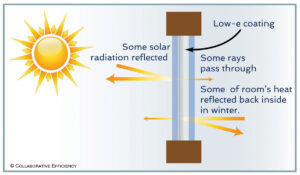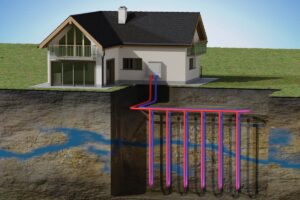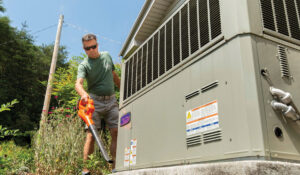
Photo Credit: Collaborative Efficiency
By Pat Keegan and Brad Thiessen
Dear Pat: We recently bought a home with windows from the 1960s that are drafty and need replacing. We would like to ensure that our new windows are energy efficient. Can you offer any tips? – Lena
Dear Lena: Replacing your windows is often the most costly and least cost-effective energy efficiency investment you can make. But there are sound reasons besides energy efficiency to invest in new windows, such as comfort, resale value and aesthetics.
As you look into window replacement, think about your goals. If reducing your energy costs is important, you should weigh an investment in new windows against the other energy efficiency opportunities you may have. An energy audit by a qualified auditor is the best way to compare your options.
The auditor can perform a diagnostic test to determine how leaky your windows are. These tests often show that windows, even old ones like yours, are not as leaky as you might think and that you have more significant air leakage problems elsewhere in the home.
You may discover there are ways to reduce heat loss through your windows without replacing them, such as storm windows or window coverings.
As you begin to explore window replacement, ask yourself if you’re happy with the number of windows you have and with the size and location. You could decide to increase or decrease the size of a window, or to replace a window with an exterior door. Sometimes these types of changes are quite affordable, but the cost can be much greater if significant changes to the wall framing are required.
When considering whether to add more windows, remember that even very efficient ones are much less effective insulators than a home’s exterior walls, which means they will be colder to the touch than the wall in the winter. Depending on orientation and shading, windows can let in too much direct sun in the summer, driving up indoor temperatures and air conditioning costs.
Window buyers have a number of choices to make. Double-pane windows are necessary to meet code for most applications, but the additional cost for triple-pane windows could be worth the investment if you live in an area with extreme temperatures. Choosing Argon or Krypton gas between the panes adds a little more efficiency.
A common option that can be well worth the investment is a low-emissivity coating added to the glass. The most important benefit of this “low-e” coating is its ability to reflect heat back into the interior space, which reduces heating bills and increases comfort. These coatings reduce solar heat gain as well, which can help with air conditioning costs.
Window frames can be made of wood, composite materials, fiberglass, aluminum or vinyl. Each has pluses and minuses in terms of cost, maintenance, durability and energy efficiency.
Fortunately, windows are rated for energy efficiency, so you don’t need to know all the details about their construction. The most important indicator of a window’s energy efficiency is the U-factor, which measures the rate the entire window loses heat. Lower U-factors are more efficient. The window framing material, the number of layers of glass and the special coatings on the glass all contribute to the overall U-factor. In more extreme climates, it makes sense to have more efficient windows.
Another simple measure to look for is the ENERGY STAR label. Only windows that are substantially more efficient than the code requires receive the ENERGY STAR label. The ENERGY STAR website (www.energystar.gov), which is maintained by the U.S. Department of Energy, has a climate zone map and a list of windows, doors and skylights that qualify for the ENERGY STAR label.
Working with a professional is important because a poor installation can result in long-term damage. Moisture problems are common if windows are not installed properly, which can create mold, mildew and rot in the wall. This can prevent the window from operating properly, or cause the paint to peel.
Bids for new windows vary a great deal, so it’s worth requesting more than one and comparing qualifications as well as price for something that will change the look and comfort of your home for many years to come.
This column was co-written by Pat Keegan and Brad Thiessen of Collaborative Efficiency. For more ideas on energy efficient kitchen remodeling, please visit: www.collaborativeefficiency.com/energytips.









